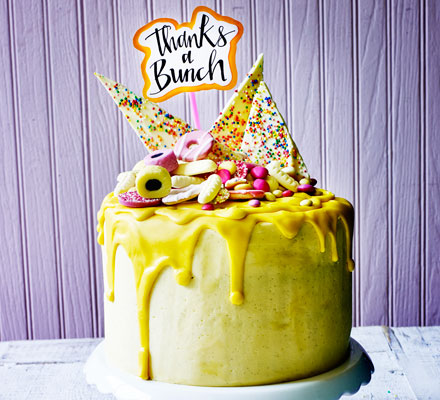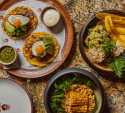Banana & custard drip cake
With its retro flavour combination, bold drippy icing and piles of bright confectionery, this showstopping layered cake ticks all the trend boxes
-
Prep:1 hrs
Cook:55 mins
plus at least 1 hr chilling - Easy
Nutrition per serving
-
kcal 851
-
fat 46g
-
saturates 28g
-
carbs 100g
-
sugars 77g
-
fibre 1g
-
protein 6g
-
salt 1.2g
Ingredients
- 450g slightly salted butter, very soft, plus extra for greasing
- 450g light muscovado sugar
- 4 very ripe bananas (about 250g/9oz peeled weight)
- 6 large eggs
- 150g natural yogurt
- 2 tbsp vanilla bean paste (or extract)
- 450g self-raising flour
- 2 tsp baking powder
- 6 tbsp custard powder
- 4 tbsp custard powder
- 2 tsp vanilla bean paste
- 4 tbsp milk
- 500g pack slightly salted butter, very soft
- 800g icing sugar
- 300g white chocolate
- coloured hundreds and thousands (the brighter the better!)
- 2 tsp vegetable oil
- yellow food colouring paste (optional)
- selection of sweets and biscuits (we used Foam Bananas, Jazzies, yellow and pink Party Rings, Liquorice Allsorts and Smarties)
Tip
Do the mathsMost of us only have two 20cm cake tins, so I’ve split the cake mixture into two batches to make the full four layers. You can, of course, just make two layers if you want to serve fewer people.
Ideal icingThe key to perfect drippy icing is using the chocolate while it’s at the right temperature – melted, but not too runny. It can set very quickly, so I’ve added a drizzle of oil to keep it fluid.
Make a cake topperPick up a greetings card with a ‘Top banana’ or ‘Thanks a bunch’ message on the front. Cut out the design and stick onto a brightly coloured paper straw for an instant cake topper – or if you’re feeling arty, design your own!
Method
Heat oven to 180C/160C fan/gas 4, grease two 20cm cake tins with butter and line the bases with baking parchment. Add 225g butter and 225g sugar to a large bowl and beat with an electric whisk until the mixture is pale and light. In another bowl or a jug, mash 3 of the bananas with a fork. Add 3 eggs, 75g yogurt and 1 tbsp vanilla, and mix to combine. Pour the wet ingredients into the butter and sugar, and add 225g flour, 1 tsp baking powder and 3 tbsp custard powder. Whisk to combine until you have a smooth batter.
Divide the mixture between the tins, spreading it to the edges, then bake on the middle shelf for 25 mins – a skewer inserted to the centre should come out clean when the cakes are cooked. Cool in the tins for 10 mins, then turn out onto a wire rack. Clean the tins, grease with more butter and line the bases as before, then bake another batch of sponges wth the remaining ingredients. Can be made 2 days before icing; once cool, wrap well in cling film and leave in a cool place, or freeze for 2 weeks.
While the cakes cool, make the icing. In a small bowl, mix the custard powder, vanilla bean paste and milk until lump-free. In a large bowl, weigh the butter and icing sugar, then mash together with a spatula (this is to prevent covering the kitchen with icing sugar!). Once roughly combined, mix with an electric mixer until smooth. Scrape in the custard mixture and beat again.
When you’re ready to assemble, clear a space for the cake in the fridge. Place one of the sponges on a plate or cake stand, and use roughly a quarter of the custard icing to stack the other cakes on top, spreading the icing right to the edges between each sponge. Use a little more icing to thinly cover the entire cake, filling in any gaps between the cake layers and using a palette knife to smooth the surface. Try not to get any crumbs in the bowl of icing – this first coat is called the ‘crumb coating’ and will trap in any crumbs, so don’t worry if it looks a little messy at this stage. Chill the cake for 30 mins until the icing is firm.
Use the remaining icing to completely cover the cake. Hold your palette knife up against the side of the cake and swoop around it to give you a nice clean, flat surface. Smooth over the top as much as possible too. Wipe the plate or cake stand clean, then chill for another 30 mins.
Line a baking tray with baking parchment. Melt the white chocolate in a bowl suspended over a pan of gently simmering water, or in short bursts in the microwave. Pour roughly a quarter of the chocolate onto the baking tray and spread it to a rectangle, roughly 12 x 20cm. Sprinkle with hundreds & thousands and set aside to cool or chill until set. Mix the oil into the remaining chocolate in the bowl and add enough food colouring to dye the chocolate a vivid yellow colour.
Remove the cake from the fridge and pour the yellow chocolate icing over the top, using a teaspoon to encourage it to drizzle down the sides. Cut the set sheet of white chocolate into pointy shards and arrange them on top of the cake (you may have to use some of the sweets and biscuits to hold them in place). Stack the remaining sweets and biscuits on top of the cake and stick in the cake topper (if using). The cake will look its best for an hour or two after decorating, but leftovers will keep for up to 3 days in the fridge.





















